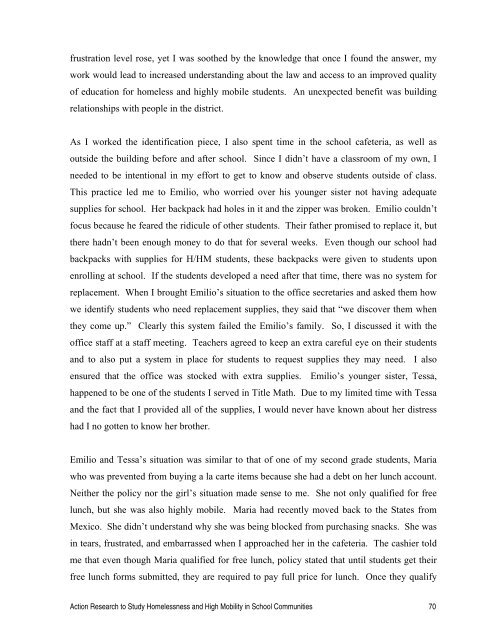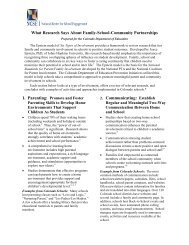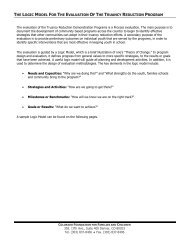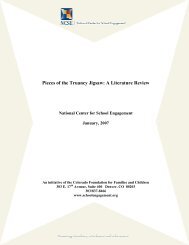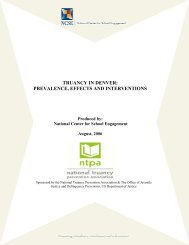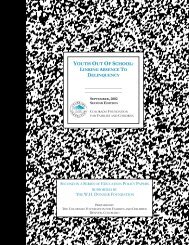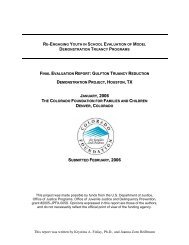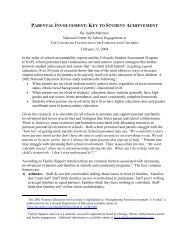Section 1: Academic Achievement - National Center for School ...
Section 1: Academic Achievement - National Center for School ...
Section 1: Academic Achievement - National Center for School ...
Create successful ePaper yourself
Turn your PDF publications into a flip-book with our unique Google optimized e-Paper software.
frustration level rose, yet I was soothed by the knowledge that once I found the answer, my<br />
work would lead to increased understanding about the law and access to an improved quality<br />
of education <strong>for</strong> homeless and highly mobile students. An unexpected benefit was building<br />
relationships with people in the district.<br />
As I worked the identification piece, I also spent time in the school cafeteria, as well as<br />
outside the building be<strong>for</strong>e and after school. Since I didn’t have a classroom of my own, I<br />
needed to be intentional in my ef<strong>for</strong>t to get to know and observe students outside of class.<br />
This practice led me to Emilio, who worried over his younger sister not having adequate<br />
supplies <strong>for</strong> school. Her backpack had holes in it and the zipper was broken. Emilio couldn’t<br />
focus because he feared the ridicule of other students. Their father promised to replace it, but<br />
there hadn’t been enough money to do that <strong>for</strong> several weeks. Even though our school had<br />
backpacks with supplies <strong>for</strong> H/HM students, these backpacks were given to students upon<br />
enrolling at school. If the students developed a need after that time, there was no system <strong>for</strong><br />
replacement. When I brought Emilio’s situation to the office secretaries and asked them how<br />
we identify students who need replacement supplies, they said that “we discover them when<br />
they come up.” Clearly this system failed the Emilio’s family. So, I discussed it with the<br />
office staff at a staff meeting. Teachers agreed to keep an extra careful eye on their students<br />
and to also put a system in place <strong>for</strong> students to request supplies they may need. I also<br />
ensured that the office was stocked with extra supplies. Emilio’s younger sister, Tessa,<br />
happened to be one of the students I served in Title Math. Due to my limited time with Tessa<br />
and the fact that I provided all of the supplies, I would never have known about her distress<br />
had I no gotten to know her brother.<br />
Emilio and Tessa’s situation was similar to that of one of my second grade students, Maria<br />
who was prevented from buying a la carte items because she had a debt on her lunch account.<br />
Neither the policy nor the girl’s situation made sense to me. She not only qualified <strong>for</strong> free<br />
lunch, but she was also highly mobile. Maria had recently moved back to the States from<br />
Mexico. She didn’t understand why she was being blocked from purchasing snacks. She was<br />
in tears, frustrated, and embarrassed when I approached her in the cafeteria. The cashier told<br />
me that even though Maria qualified <strong>for</strong> free lunch, policy stated that until students get their<br />
free lunch <strong>for</strong>ms submitted, they are required to pay full price <strong>for</strong> lunch. Once they qualify<br />
Action Research to Study Homelessness and High Mobility in <strong>School</strong> Communities 70


